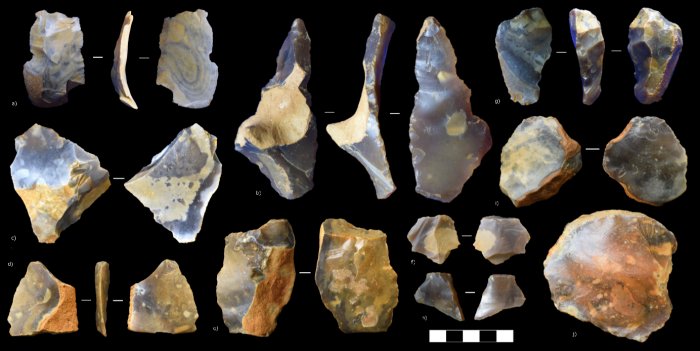Jan Bartek – AncientPages.com – After six years of excavations, University of Cambridge archaeologists reveal in their study led by Dr Alastair Key from the Department of Archaeology at the University of Cambridge, that early humans lived on the River Stour banks in Kent 712, 000 to 621, 000 years ago and reoccupied the region during an ice age around 440, 000 years ago.

A selection of the flake artefacts recovered from the excavations at Old Park, Canterbury (UK). Source
For over a century, it has been established that early humans inhabited the banks of the ancient Stour River in Canterbury, Kent, United Kingdom. This conclusion is supported by the discovery of thousands of Palaeolithic stone artefacts in this area since the 1920s. These artefacts date from 712,000 to 621,000 years ago. Researchers further found the possibility that humans occupied these northern latitudes during this harsh climatic event. The makers of these very early tools are a species commonly known as Homo heidelbergensis.
An intriguing discovery was made regarding artifacts created by later populations of Homo heidelbergensis, who are generally considered the ancestors of early Neanderthals. Approximately 440,000 years ago, during one of Britain’s most severe ice ages, the Stour River deposited a layer of gravel that was subsequently covered by sand. Between these two sediment layers, archaeologists uncovered remarkably sharp stone tools.
Dr. James Clark from the University of Cambridge explains that humans were making flint tools directly on the gravel during this ice age, and these tools were quickly covered before their edges broke. This finding is exciting because it was thought impossible for humans to survive in Britain during these cold phases, showing the adaptability of early populations.
However, these populations may only have been summer visitors, or could have occupied the region during the brief, warmer interglacial periods found within the broader glacial event.

Four of the handaxes recovered from Fordwich Pit, Old Park, Canterbury (UK). Two of the rough elongated forms can be observed in the top row, while two of the more heavily flaked and likely younger handaxes are on the bottom row. Source
In addition to the 440,000-year-old artifacts, researchers also unearthed microscopic plant fossils known as phytoliths. These findings suggest that these ancient populations inhabited a relatively cold grassland environment. While the data are interpreted with caution, they indicate that these early humans may have shared an ecological niche with grassland fauna, including extinct species of horses and rhinos.
“If humans lived in a cool-to-cold grassland ecosystem at this time, even if only during the summer, it raises important questions about how they did this.,” says Dr Michaela Leonardi, a University of Cambridge and Natural History Museum palaeoecologist who modelled Old Park’s ancient environment as part of the research.
“Did these populations track migrating prey? Could they have made clothing with sewn seems or shelters to guard against the cold?”

An artist’s interpretation of the Old Park Palaeolandscape during a warm interstadial within the Anglian glaciation event, c. 440,000 years ago. Image credit: Nguyen Ngoc My Ha – source
The study plays a crucial role in providing historical context for the hundreds of stone tool artifacts discovered at the site.
A tool category, known as Acheulean handaxe, is hard to interpret due to two distinct types: one highly shaped and ovate, the other roughly made and elongated. Two archaeological layers separated by 200, 000 years suggest that these tools were made by different human populations with potentially different cognitive and behavioral capabilities.
The roughly made handaxes are possibly the oldest in northern Europe and are atypical for the region, while the more refined ones share features common to other Acheulean sites. The research continues to analyze stone tool artefacts historically found at the site.
Source
Paper
Written by Jan Bartek – AncientPages.com Staff Writer
